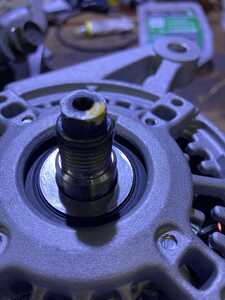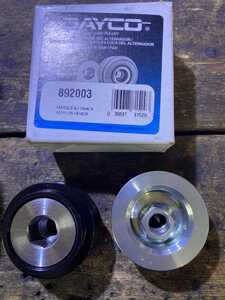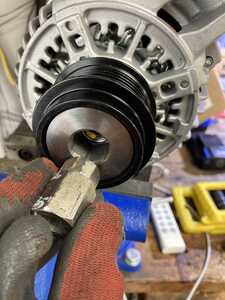I now have something to report. Since adding my new passenger side motor mount I think my impressions were offset because there was more of a difference from going back to a OEM mount from a stiff poly mount. I think the OEM mount changed the position of how the motor sits from how it was. I had some other weird issues like I was driving on worn CV joints when I put a lot of load on the drivetrain and I think that was due to the change in angle of the drivetrain with the new mount but its gone now.
I let the car sit for months and I think the weight of the engine has placed stress on the new rubber and it has changed for the better.
I started driving the car about a month ago and chalked up the pulley as not having much benefit. As I kept driving the car and no longer paying attention to the pulley I noticed how smooth my gear shifting has become just driving the car normally. The timing of engaging the clutch and going into the next gear is smooth as silk, I mean noticeable ease of getting into gear. I think ISpy describes it well.
Its possible that reducing the alternator drag shock that reduces engine speed more abruptly between shifts might actually make matching the gears better by helping the synchronizers to match gear speeds better kind of like a throttle blip that you don't hear or notice. Im just thinking out loud but could it be like match shifting where you have less abrupt shifts so the car does not become unsettled but at a lower rpm and all the time. I know it has been theorized that the engine slows down faster bringing down the engine speed but thats doesn't appear to be happening, just the opposite.
I have owned this car for a very long time and know my car like the back of my hand with small changes. This is for sure a change but I was actually concentrating only on one area which was performance shifting but its best felt just driving around at normal gear changes.
I was thinking about this yesterday as I cant wrap my head around what is happening. It then occurred to me that this OAD pulley keeps the engine from decelerating rapidly during the shift. Even though it is felt in the shifter being smoother I think the actual effect is felt similar to a mild form of rev matching but in this case its all the time which includes upshifts.
I have a grabby kevlar clutch that if I let out too quickly I can bog the engine when I shift at lower RPMs. Therefore the effect I feel is greater when I shift from 1st to second but I feel it the most from 2nd to 3rd. The weird thing is its mostly felt in the shifter like it has improved but that might be a phantom perception.
Smooth is the word! Mine is still going fine, as is the one I put in the TSX before I sold it. I've been trying to source one that will work on my Subaru but it's looking unlikely. Glad you're enjoying it!
I believe I was wrong. I now believe the change is in the gear box and that is why getting into gear during up shifts feels so much more positive.
I had a problem wrapping my head around this so I decided to do a deep search. On a Smart car forum they were doing the same thing and one person said it was not only smoother the up shifts were quicker. They have a dual clutch transmission I think. They believe that engine spins down quicker satisfying the conditions for the next gear change by the ECU.
Basically in a nutshell I was wrong about what happens when the alternator is decoupled. Instead of decreasing the rate of rpms dropping it actually makes the rpms come down quicker like a lightweight flywheel. This is what was originally thought and it is true but also a good thing. I also found a tech article siting that lightweight flywheels do make upshifts easier but it is negated when you re-engage the clutch because of the loss of momentum in the lightness that can bog the car down in certain situations.
When up shifting you want the input shaft speed to match the next gear as closely as possible so they mesh without grinding and for the ease of sliding into gear. For that reason we use synchronizers to slow down the next gear to make this happen in a modern transmission however synchronizers are not perfect if you over power them in the moment during fast shifting which can cause damaged due to wear over time and will result it un-smooth shifting.
I now believe for a split second during the gear change the OAD pulley is decoupled when we let of the gas spinning the engine down quicker and just before the clutch is simultaneously disengaged with the stick following a path of disengaging the gear and engaging the next higher gear. That little bit of decelerated speed makes getting into the next gear easier and quicker because the synchronizers timing of spinning down the gear to match is easier. This might be the reason for the smooth upshifts being that its easier on the synchronizers matched with less resistance when re-engaging the clutch since the OAD pulley is still disengaged during the event.
I believe I was wrong. I now believe the change is in the gear box and that is why getting into gear during up shifts feels so much more positive.
I had a problem wrapping my head around this so I decided to do a deep search. On a Smart car forum they were doing the same thing and one person said it was not only smoother the up shifts were quicker. They have a dual clutch transmission I think. They believe that engine spins down quicker satisfying the conditions for the next gear change by the ECU.
Basically in a nutshell I was wrong about what happens when the alternator is decoupled. Instead of decreasing the rate of rpms dropping it actually makes the rpms come down quicker like a lightweight flywheel. This is what was originally thought and it is true but also a good thing. I also found a tech article siting that lightweight flywheels do make upshifts easier but it is negated when you re-engage the clutch because of the loss of momentum in the lightness that can bog the car down in certain situations.
When up shifting you want the input shaft speed to match the next gear as closely as possible so they mesh without grinding and for the ease of sliding into gear. For that reason we use synchronizers to slow down the next gear to make this happen in a modern transmission however synchronizers are not perfect if you over power them in the moment during fast shifting which can cause damaged due to wear over time and will result it un-smooth shifting.
I now believe for a split second during the gear change the OAD pulley is decoupled when we let of the gas spinning the engine down quicker and just before the clutch is simultaneously disengaged with the stick following a path of disengaging the gear and engaging the next higher gear. That little bit of decelerated speed makes getting into the next gear easier and quicker because the synchronizers timing of spinning down the gear to match is easier. This might be the reason for the smooth upshifts being that its easier on the synchronizers matched with less resistance when re-engaging the clutch since the OAD pulley is still disengaged during the event.
Correct, engine revs should fall faster with less mass decelerating and have less shock from less mass spinning, the engine revs falling faster and with less mass when throttle is released should allow for grabbing the next gear up more easily and for a little less load on the clutch/trans to get the whole drive line spinning at the same speed to continue accelerating. It's a small difference but something that I could pretty plainly feel and one that to me makes the car much 'happier' feeling if I can assign some human emotion to it. Shift shock and drive line shock when abruptly releasing throttle and then re-accelerating is much less to me. I have a hard front mount and a new belt side mount but also not a MR2 so having the engine in front vs behind probably makes some difference as well. Overall I feel like for as relatively easy and inexpensive as this is for the ease it adds to driving and the smoothness it lends to the vehicle it's worth it. I'm all for things that make a car feel better even if they don't make it objectively faster. My experiences with the car on Tail of the Dragon were great and even going back to roads I know and driving them it feels nicer with than without. Numbers are great but sometimes it's more about the feel and spirit of a vehicle.
I can't believe you nerds (in the most loving way I say nerds) talked for 11 pages about an alternator pulley!
My original alternator failed on Wednesday on my SMT spyder. So I got a new replacement and dug out the overrun pulley I bought last year amd installed it. I drove it briefly and found I had cracked a flex pipe section while jacking the engine around to remove the right engine mount. I didn’t notice any difference on the test drive.
I make Amateur Armrests - see the Commercial Forum. I also have SMT repair seals available.
Sorry to hear of your flex pipe failure. That is a headache. The OAD pulley, IMHO, makes a minuscule difference. I think the stress it removes from the drivetrain is of greater value than the performance gained.
Oh I forgot to report that I installed this as well. Noticed little difference but I do think it's a bit smoother clutching in and out now. However I already have a lightweight flywheel so it does mean there's less of a difference to make.
The install was super easy though!
2000 Toyota MR2 Spyder, 2021 Lexus UX 250h F Sport
Good morning,
Question for anyone who may be able to offer some advice. Currently in the final stages of a 2zz swap and decided at the same time to try this decoupler out.
I went with Toyota part #274150T060
After the install, I'm getting an A/C flashing light. Tried jumping the relay and no avail. A/C clutch does not seem to be engaging. I'm wondering if anyone encountered any issues with the A/C system after this mod. While I continue to troubleshoot, here's what I wonder may be going on:
A/C switched on, ECU increases idle to compensate, alternator decoupler clutch has some reaction, causing a transient difference between engine RPM and A/C compressor, causing it to switch off/limp mode to protect belt.
What do you think? Has anyone encountered any issues with A/C after this?
Thanks all in advance
@karmality Congrats on your swap! Sorry to hear you're having AC trouble. I don't see how the alternator pulley could be a culprit thou... It merely isolates the alternator from the belt system under certain conditions. I don't see how a difference in speed could occur between crank pulley and AC pulley.
Have you tried applying power directly to the AC clutch itself to see if it engages? (With vehicle off)
If yes, have you checked your refrigerant levels to make sure you don't have a leak? Most AC systems have a pressure switch, which will disable the AC clutch if pressures are too far out of spec.
Thanks for the message. I forgot to mention, I checked the coolant pressure and it was a bit high, around 120. I'm still troubleshooting, but before I replace the pressure switch really want to drill down whether the decoupler could beat possible culprit
@karmality Then just swap the original alternator pulley back in? Doesn't take long.
I had a chance to drive my car for the first time this season. Like most mods I got use to any advantages however little if any performance however the shifting is so nice just tooling around. During the shift it goes in to the next gear with a nice positive click. The best way to describe it is Mazda MX5 shifting feel which is one of the best I have felt. I see this modification more or less an indirect synchronizer modification. Its possible that my synchros are a little worn and this is helping a lot.
Come on Dev, take the car out more. At this rate your "new" Indy 500s will be old before you wear them out !! 😆
I know right. It’s going to be expensive this summer.



